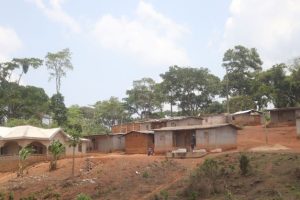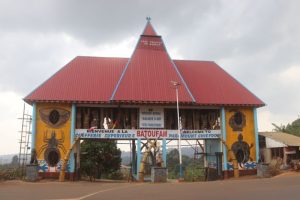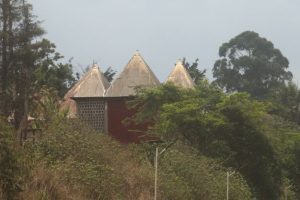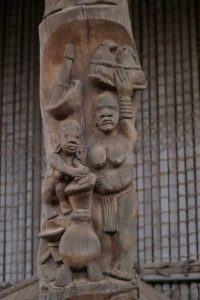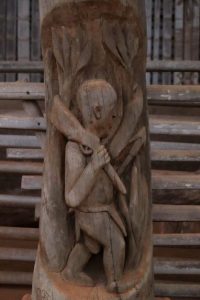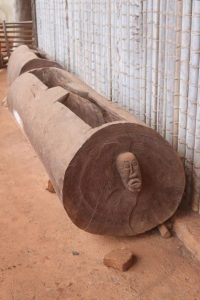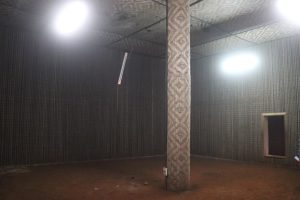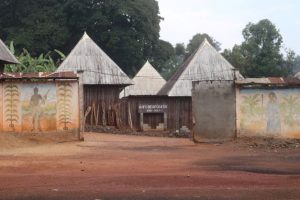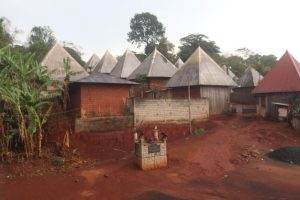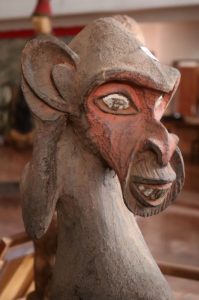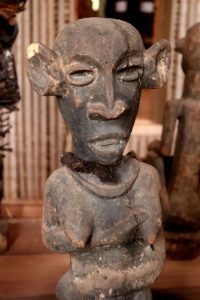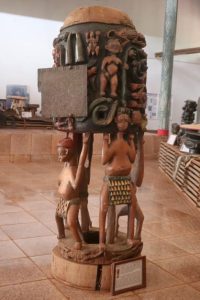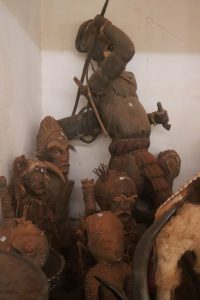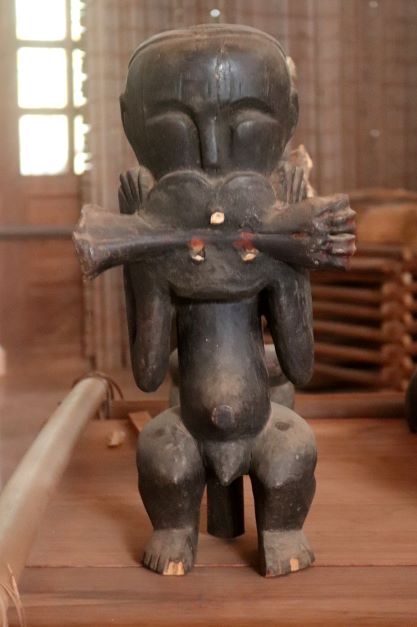The Bamileke
Mayou has organised another car for today, to take us to the west of the country, the Bamileke area. The Bamileke are a tribe that migrated into their present area in Western Cameroon from further Northeast. They have a well organised societal structure, which appealed to the British colonisers who handed them a certain amount of control. Along the road we see many signs to chefferies, these the houses of the village chiefs, or kings. There are several levels of chefferie, 3rd category, 2nd category, and then just chefferie. Some may even be Chefferie Superieure, like the one we pass in Batoufam. Through these chiefs the community is intricately organised, and especially the super chefs, the kings, are well regarded. A king, also called fon, is the spiritual, political, judicial and military leader in one person. Which, of course, needs to be sealed by having many wives, and even more children. Out of which the king chooses his own successor, which is only revealed after his death. There is a council of ministers, and several secret societies, which adds to the complexity of the society. There is not one Bamileke king, there are a number of kingdoms, each with their own king.

the typical Bamileke architecture with pointed roofs on square huts, the more important, the more roofs
One of the most important ones is the Chefferie of Bandjoun. An enormous complex, which starts already outside, where on the large village square is lined with stands for when there are processions or other festivities. The compound is entered under an arch, these days made of concrete, which leads to the Royal palace. On the sides are accommodation buildings, in the traditional Bamileke style – square huts with bamboo walls, and with tall conical roofs, originally thatched but now replaced by corrugated iron.

poor quality photo, I apologise (bad light, bad camera settings), but it is the only one I have of the Bandjoun royal palace
The palace is just a much larger version of the traditional huts, also bamboo walls, and this time covered with an enormous thatched roof, which gives the impression that the building is round. This is enhanced by the circle of support pillars, holding up the roof, each and every one of the poles having been intricately wood-carved, with spiritual, mask-like figures or everyday community scenes. Some look old, others are obviously more recently additions, replacement probably.
We are first led into the museum, next to the palace. Inside, unfortunately, no photos. Our guide explains the various aspects of the culture, and the economy – the Bandjoun people are, apparently, excellent blacksmiths, but also skilled in beadwork, of which some fabulous examples, in the form of chairs, masks and other decorative pieces, are on display. Soon after the tour starts, it begins to rain, and not a little. On the corrugated iron roof, which makes our guide almost inaudible, even though he has raised his voice significantly. Next the light goes off. If I had been wondering why our guide had been carrying a fluorescent tube, I now know: this was his torch. Very well prepared! Luckily, the light comes back and the rain stops, almost, by the time we move to inside the Bandjoun palace itself, an empty shell, which is only being filled, with people, if the king is in court. A bit of a let-down, after the museum. But overall a great visit, very impressive.
Yesterday evening I had checked a few more possibilities in the area, and one of them was the Baham Museum, part of the Baham Chefferie. The palace is out-of-bounds, and in any case doesn’t look anywhere near as interesting as the Bandjoun one, but the museum is something else. You probably know of my interest in ethnic artefacts, and here I am not going to be disappointed. The museum has been set up as a community museum, which is to say that all of the objects inside are owned by members of the community, who occasionally – at times of ceremonies, for instance – come to claim their possessions, and bring them back afterwards. So each and every piece here is authentic, and being actively used – an important aspect for ethnological enthusiasts. And there are some fabulous objects in between them, cloths of the king, and of previous kings, ancestor sculptures, masks, two huge drums, several royal chairs. We have far too little time to look at each piece in detail, not in the least because our guide, the museum’s curator Albert, keeps on enthusiastically telling more and more stories every time he stops at an object. The worst thing? They have a whole corner with sculptures for which they even don’t have the space to exhibit them. Sounds familiar.
Here the disadvantage of group travel shows. Even though we are temporarily on ourselves, we still need to meet up in time, in the not too distant future. Otherwise we would no doubt have spent more time here, and probably seen other chefferies and museums, too. Now we may have to come back one day, who knows?
Next: the Foumban palace


